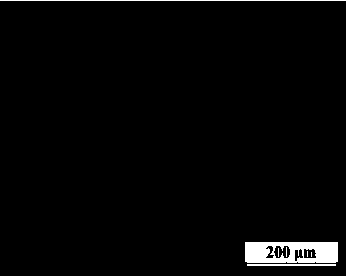Method for recycling steel scraps
A technology of steel shavings and aluminum shavings, applied in the field of recycling steel shavings, can solve the problem that the effective utilization rate is not higher than 70%, and achieve the effect of low forming temperature
- Summary
- Abstract
- Description
- Claims
- Application Information
AI Technical Summary
Problems solved by technology
Method used
Image
Examples
Embodiment 1
[0017] This embodiment specifically implements a method for preparing and recycling iron filings. The specific process is: add a layer of ZL101A aluminum heated to 605 °C at the bottom of the die cavity of a compression mold made of die steel with a wall thickness of 15 mm and a section diameter of 100 mm. Alloy chips, the average size of the chips is 50μm, the total impurity content is 0.8wt.%, and the thickness of the aluminum chips is 1.0mm; then add a layer of steel chips heated to 605°C, the average size of the steel chips is 100μm, and the total impurity content is 0.9wt .%, the thickness of the steel chips is 1.5mm; then the surface of the steel chips in the die cavity of the pressing die is pressed by the stamping head made of die steel, the pressure is 30MPa, and the holding time is 5s; the stamping head is lifted and then Add a layer of aluminum chips, repeat the above steps until the material obtained in the pressing mold reaches the required thickness; keep the pres...
Embodiment 2
[0020] This embodiment specifically implements a method for preparing and recycling iron filings. The specific process is: add a layer of hot water heated to 620° C. ZL102 aluminum alloy chips, the average size of the chips is 300 μm, the total impurity content is 0.9wt.%, and the thickness of the aluminum chips is 2.0 mm; then add a layer of steel chips heated to 620 ° C, the average size of the steel chips is 500 μm, and the total impurity content is 0.9wt.%, the thickness of the steel chips is 2.5mm; then the surface of the steel chips in the die cavity of the pressing die is pressed by the stamping head made of die steel, the pressure is 80MPa, and the holding time is 3s; the stamping head is lifted Then add a layer of aluminum chips, repeat the above steps until the material obtained in the pressing mold reaches the required thickness; keep the pressed material in the pressing mold at 620°C for 6 hours, and then heat it at a speed of 10°C / min. Cool the composite of steel ...
Embodiment 3
[0022] This embodiment specifically implements a method for preparing recycled iron filings. The specific process is: add a layer of ZL101A aluminum heated to 610°C at the bottom of the die cavity of a compression mold made of die steel with a wall thickness of 15 mm and a section diameter of 150 mm. Alloy chips, the average size of the chips is 100μm, the total impurity content is 0.8wt.%, and the thickness of the aluminum chips is 1.5mm; then add a layer of steel chips heated to 610°C, the average size of the steel chips is 200μm, and the total impurity content is 0.7 wt.%, the thickness of the steel chips is 2.0mm; then the surface of the steel chips in the die cavity of the pressing die is pressed by a stamping head made of die steel, the pressure is 50MPa, and the holding time is 4s; after the stamping head is lifted Add another layer of aluminum chips, repeat the above steps until the material obtained in the pressing mold reaches the required thickness; keep the pressed ...
PUM
| Property | Measurement | Unit |
|---|---|---|
| thickness | aaaaa | aaaaa |
| thickness | aaaaa | aaaaa |
| thickness | aaaaa | aaaaa |
Abstract
Description
Claims
Application Information
 Login to View More
Login to View More - R&D
- Intellectual Property
- Life Sciences
- Materials
- Tech Scout
- Unparalleled Data Quality
- Higher Quality Content
- 60% Fewer Hallucinations
Browse by: Latest US Patents, China's latest patents, Technical Efficacy Thesaurus, Application Domain, Technology Topic, Popular Technical Reports.
© 2025 PatSnap. All rights reserved.Legal|Privacy policy|Modern Slavery Act Transparency Statement|Sitemap|About US| Contact US: help@patsnap.com

